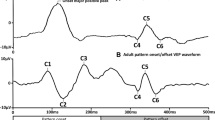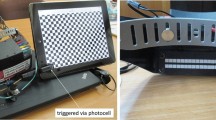Abstract
Pattern-reversal visual evoked potentials (PR-VEPs) and EEG were recorded in 14 phenylketonuric (PKU) children on a low-phenylalanine (phe) diet; the data obtained were correlated with metabolic parameters, namely, the actual phe plasma level, the mean phe plasma level in the last year, an the beginning of the diet. PR-VEPs seem to be more sensitive than EEG in detecting neurophysiological derangements in these subjects; in fact PR-VEPs were pathological in six patients while EEG detected three; no significant alterations were found in the neurophysiological tests among the children with good metabolic control, and only one child was abnormal among the six on an early dietetic regimen; in contrast, six of the nine subjects presenting with high mean phe plasma levels (>10 mg/100 ml) and five of the eight whose diet started after the 2nd month of life showed pathological PR-VEPs.
Similar content being viewed by others
References
Blaskovics ME, Engel R, Podosin RJ, Azen CG, Friedman EG (1981) EEG pattern in phenylketonuria under early initiated dietary treatment. Am J Dis Child 135:802–808
Clayton BA, Moncrieff AA, Pampiglione G, Sheperd J (1966) Biochemical and EEG studies in PKU children during phenylalanine tolerance test. Arch Dis Child 4:267–272
Creel D, Buelher BA (1982) Pattern evoked potentials in phenylketonuria. Electroencephalogr Clin Neurophysiol 53:220–223
De Giorgis GF, Antoniozzi I, De Castello PG, Rosano M, Loizzo A (1983) EEG as a prognostic tool in phenylketonuria. Electroencephalogr Clin Neurophysiol 55:60–68
Donker DNJ, Reits D, Van Sprang FJ, Storm van Leeuwen W, Wadman SK (1979) Computer analysis of the EEG as an aid in the evaluation of the dietetic treatment in phenylketonuria. Electroencephalogr Clin Neurophysiol 46:205–213
Folling A (1938) Über die Ausscheidung von Phenylbrenztraubensäure in dem Harn als Stoffwechelanomalie in Verbindung mit Imbezillität. Hoppe Seylers Z Physiol Chem 256:1
Halliday AM (1982) The visual evoked potential in the investigation of chiasmal and retro chiasmal lesions and field defects. In: Halliday AM (ed) Evoked potentials in clinical testing. (Clinical neurology and neurosurgery monographs, vol 3) Churchill Livingstone, Edinburgh, pp 235–283
Herrero E, Aragon MC, Gimenez C, Valdivieso F (1983) Inhibition by L-phenylalanine of tryptophan transport by synaptosomal plasma membrane vesicles: implications in the pathogenesis of phenylketonuria. J Inherited Metab Dis 6:32–35
Hommes FA, Eller AG, Taylor EH (1982) The effect of phenylalanine on myelin metabolism in adolescent rats. In: Cockburn F, Gitzelmann R (eds) Inborn errors of metabolism in humans. MTP Press, Lancaster, pp 193–199
McKean CM (1972) The effects of high phenylalanine concentrations on serotonine and catecolamine metabolism in the human brain. Brain Res 4:469–476
Onofrij M, Bodis Wollner I (1982) Dopaminergic deficiency causes delayed VEPs in rats. Ann Neurol 11:484–490
Shafer EWP, McKean CM (1975) Evidence that monoamines influence human evoked potentials. Brain Res 99:49–58
Shah SN, Peterson A, McKean CM (1972) Lipid composition of human cerebral white matter and myelin in PKU. J Neurochem 19:2369–2376
Tourian AY, Sidbury JB (1978) Phenylketonuria. In: Standbury IB, Wyngaarden D, Fredrikson S (eds) The metabolic basis of inherited disease, 4th edn. McGraw-Hill, New York, pp 241–245
Zemon V, Kaplan E, Ratcliff F (1980) Bicuculline enhances a negative component and diminishes a positive component of the VEPs in the cat. Proc Natl Acad Sci USA 77:7476–7478




